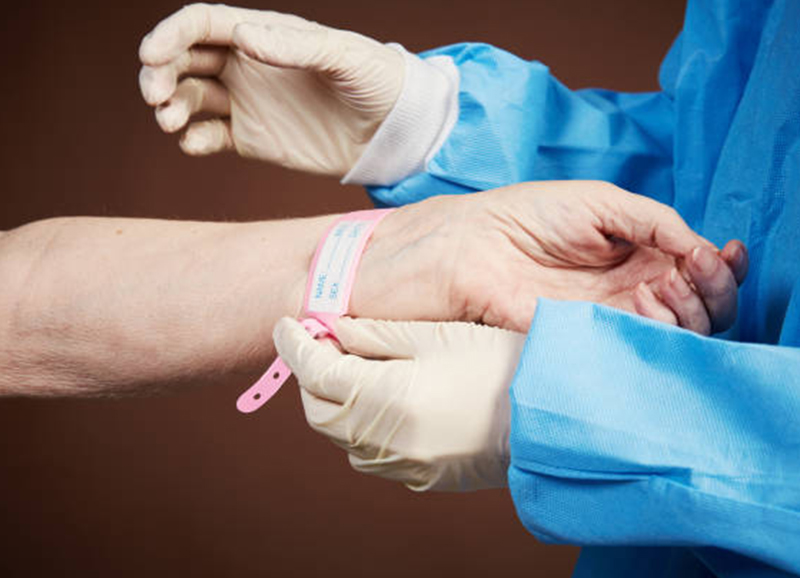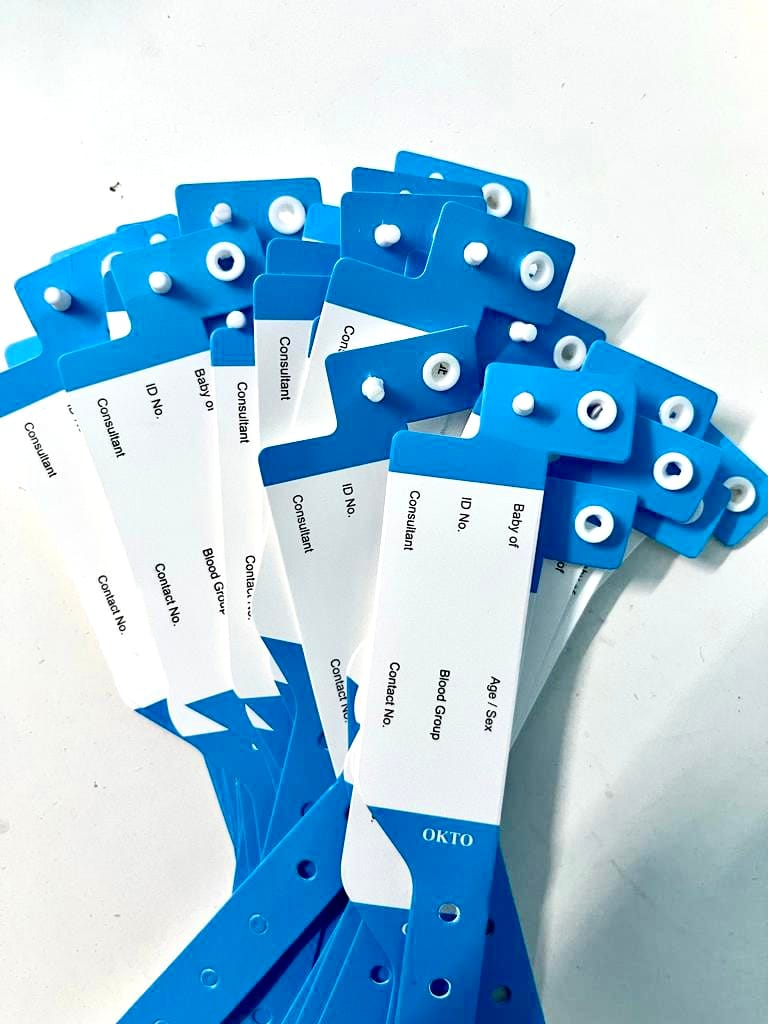Why Person Recognition Bands Are Necessary for Every Health Care Center
In the facility landscape of health care, patient recognition bands offer as a fundamental component in safeguarding patient security and decreasing clinical errors - Patient Identification Band. Exploring this concern reveals a much deeper understanding of client security and top quality treatment.
Averting Medical Mistakes
In the realm of healthcare, protecting against medical mistakes is critical to guaranteeing individual safety and quality of treatment. One of one of the most important consider minimizing such errors is the exact identification of patients. Misidentification can cause improper therapies, medication mistakes, and even medical errors, every one of which can have devastating repercussions for individuals and healthcare service providers alike.
Client identification bands function as an essential device in this preventive technique. These bands usually include crucial details, such as the client's name, day of birth, and unique recognition number, permitting medical care professionals to verify the individual's identification quickly and precisely prior to carrying out any kind of care. Ensuring that these bands are appropriately applied and constantly used across all medical care settings is essential.
Moreover, the execution of electronic health and wellness records (EHR) can enhance the performance of client recognition bands by incorporating them with electronic systems that flag potential discrepancies. Normal training and adherence to methods pertaining to using patient recognition bands can significantly lower the chance of errors. In summary, durable patient recognition techniques are essential for minimizing medical errors and safeguarding patient welfare within healthcare settings.
Enhancing Client Safety And Security
Patient safety and security is a multifaceted concept that includes numerous techniques and practices designed to protect individuals from injury during their medical care experience. One essential component in improving individual safety is the implementation of person identification bands. These bands function as an important device for making sure that healthcare service providers can properly recognize people, thus reducing the risk of misidentification.
The existence of individual identification bands considerably lowers the opportunities of carrying out wrong medications, conducting unexpected procedures, or falling short to recognize allergies. By fastening an unique identifier to every person, healthcare centers create a trusted system that promotes liability and vigilance amongst clinical staff. This positive technique not only boosts the safety of clients however likewise instills a sense of count on the healthcare system.
In addition, person identification bands add to a standardized protocol that can be conveniently incorporated right into digital health records. Patient Identification Band. This assimilation makes certain that important individual details is readily accessible, additional enhancing safety and security actions. Ultimately, the reliable use of identification bands is a necessary practice that underpins a culture of safety, aiming to protect people and enhance general healthcare results
Improving Interaction
Efficient interaction is essential in the healthcare setting, as it directly impacts patient security and care high quality. Client recognition bands act as a critical device for boosting communication among health care service providers. By plainly presenting important client information such as name, day of birth, and clinical record number, these bands assist in precise recognition, minimizing the threat of errors in treatment and medication management.
Additionally, individual identification bands promote a culture of accountability and verification within medical care groups. When all team member are equipped with prompt access to reputable patient identification, the possibility of miscommunication decreases considerably. For example, throughout handoffs in between shifts or More Info interdisciplinary examinations, the existence of identification bands ensures that everybody entailed gets on the very same web page regarding patient identification and clinical history, thereby minimizing misconceptions.
Additionally, these bands can integrate with electronic health records (EHR), permitting smooth communication of client info across different platforms. This connection not only improves the efficiency of information sharing but likewise supports an extra collaborated technique to client care. Eventually, the adoption of patient identification bands is vital for enhancing interaction, thus contributing to better health outcomes and guaranteeing that clients receive the highest criterion of treatment.

Streamlining Process
The execution of patient identification bands substantially adds to improving operations within medical care atmospheres. By providing prompt and clear recognition of patients, these bands minimize the time health care professionals invest validating individual information. This efficiency reduces the capacity for errors, enabling team to concentrate on straight patient treatment instead of administrative tasks.
With standard identification processes, healthcare groups can rapidly access necessary individual data, consisting of case history, allergies, and therapy strategies. This fast access enhances decision-making and enables prompt interventions, eventually improving patient results. The usage of identification bands assists in far better control among multidisciplinary groups, making sure that all members have the appropriate information at their fingertips.

Furthermore, individual identification click this link bands can be incorporated with digital health and wellness record (EHR) systems, better enhancing operations. By scanning a band, doctor can swiftly upgrade and share information, consequently minimizing redundancy and enhancing documents initiatives. This combination aids maintain a continuous flow of details, which is crucial in vibrant health care settings.
Ensuring Regulatory Compliance
In today's healthcare landscape, ensuring regulative compliance is vital for preserving patient security and organizational integrity. Client identification bands play an important role in meeting numerous regulatory requirements, such as those stated by the Joint Compensation and the Centers for Medicare & Medicaid Services (CMS) These organizations stress the necessity of exact patient recognition to minimize medical errors and enhance the quality of treatment.

Applying standard person recognition bands assists medical care centers comply with laws that call for accurate person recognition at every phase of treatment. This includes medicine administration, surgeries, and blood transfusions. Non-compliance can result in major repercussions, consisting of fines, loss of certification, and, most importantly, endangering client security.
Moreover, using innovation, such as barcoding and RFID systems integrated with patient identification bands, can even more boost conformity efforts by guaranteeing that the ideal person gets the ideal treatment at the correct time. By focusing on the execution of robust individual recognition systems, health care centers not just follow regulatory criteria yet likewise promote a society of safety and security and liability, inevitably enhancing client end results and rely on the healthcare system.

Final Thought
In verdict, patient recognition bands act as a fundamental element in medical care facilities, dramatically contributing to the avoidance of clinical mistakes and the enhancement of client safety and security. By enhancing communication amongst clinical staff and streamlining operations, these bands help with much more reliable healthcare delivery. Furthermore, their role in making certain compliance with regulative standards can not be overstated. Inevitably, the application of person recognition bands is vital for cultivating a more secure healthcare atmosphere and enhancing overall client outcomes.
In the complex landscape of medical care, person recognition bands serve as a fundamental element in securing person security and minimizing clinical errors. These bands normally contain essential information, such as the client's name, date of birth, and distinct identification number, allowing healthcare professionals to verify the client's identity swiftly and properly prior to carrying out any kind of treatment.Executing standardized patient identification bands helps medical care centers abide with guidelines that call for exact individual identification at every stage of treatment.In final thought, individual recognition bands offer why not find out more as a fundamental element in medical care centers, substantially contributing to the prevention of clinical errors and the enhancement of patient safety and security - Patient Identification Band. Inevitably, the application of client identification bands is important for fostering a more secure health care atmosphere and improving overall patient outcomes
Comments on “Why Every Medical Facility Needs To Execute Patient Identification Band for Its Patients”